What Size Trolling Motor Do I Need?
Choosing the correct trolling motor for your boat actually depends on a handful of factors. The most important things you’ll want to consider when selecting a trolling motor are:
- The type of boat you have (pontoon or standard hull)
- Where you plan to mount the trolling motor (bow mount motor or transom mount)
- The size of your vessel (larger boats will require more thrust)
- Battery power of your boat (larger trolling motors may draw too much from your batteries if you aren’t prepared)
Once you have determined these factors, you still need to consider things like shaft length for your trolling motor and whether or not you’ll be boating freshwater or saltwater before making a final decision. In addition, there are some fun additions you can get with a lot of modern trolling motors that don’t relate to the size at all, things like Bluetooth connectivity so you can operate it from your smartphone, which can affect price significantly.
Standard Hull vs Pontoon Boat
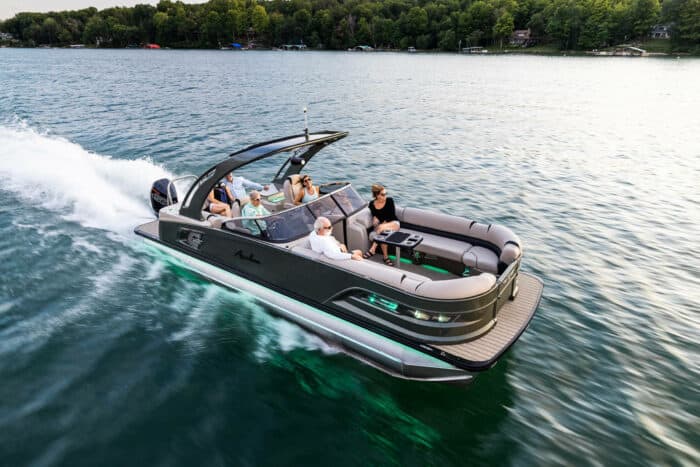
Any boat can use a trolling motor but you do need to make some adjustments if you have a pontoon boat. The design of pontoon boats is such that you can’t use the exact same kind of trolling motor that you would on a jon boat or a bass boat, simply because you’re going to be significantly higher on the water. So a trolling motor on a pontoon boat is going to require a longer shaft regardless of where and how you mount it.
Like other boats you can mount your trolling motor bow or stern. Bow is better for maneuverability and also if you plan to do literal trolling when you fish. But it’s more expensive and requires more work to mount on the bow.
For a pontoon boat you’re going to want, at a minimum, a shaft length of about 52 inches but 60 inches is probably your best bet. In addition, because of how a pontoon rides on the water, you’ll need to approach thrust differently as well. Small jon boats can get away with less thrust overall, but a pontoon would benefit from about 55 lbs of thrust or more at minimum, depending on the overall size of the vessel.
For a pontoon boat, consider that you’ll want 5 lbs of thrust for every 400 lbs of boat at the very least. That includes passengers and gear.
Some people use the calculation of taking the total weight of the pontoon, dividing it by 100 and then multiplying it by 2. So if you had a 4000 lb boat, you’d do 4000/100 = 40 x 2 = 80 lb of thrust.
This calculation is very general and, especially on smaller boats, you may find yourself underpowered as a result. More thrust is never a bad idea for a pontoon because the hull is less hydrodynamic than a standard v-hull vessel. You can use the boost in thrust to make up for it.
I’d recommend adding 10 to the calculation as a bare minimum. So 90 lbs of thrust for that size boat. And you’ll also want a motor that measures 24V or 36V as well, to ensure it has the power to give you that thrust. Naturally, you’ll want some deep cycle batteries to keep it fully powered as well.
One other consideration here regarding hulls is a flat boat like a jon boat versus a V-hull like a bowrider. The bowrider, or any v-hull, is going to have more drag working against it. That means your trolling motor will have to work a little harder and may benefit from a little more power than what you might need on the same sized flats boat.
Mount Location for Trolling Motors

Typically you have three places you’ll potentially be mounting you trolling motor.
- Bow mounted
- Transom or stern mounted
- Engine mounted
Bow Mount Trolling Motor
Bow mounted motors are arguably the best trolling motors for anglers who are really into fishing and go all out. The maneuverability and convenience is much better with a bow mounted trolling motor. This type of mounting allows you to steer and control your progress much easier because the motor is pulling the boat and therefore leading the way, rather than a stern mount which pushes the boat and is therefore a little clumsier.
Bow mounts have better control options including things like foot controls. They tend to also have more of those fun features like Bluetooth control.
Your flip side here is that it is more expensive to get a bow mounted trolling motor, takes more effort to mount it, and it takes up more room. If you have a bigger boat, it’s less of an issue because the size of the motor and the space it takes up is less noticeable. But on a smaller vessel, a bow mounted trolling motor can be very obtrusive and could potentially be too big.
Transom Mounted Trolling Motors
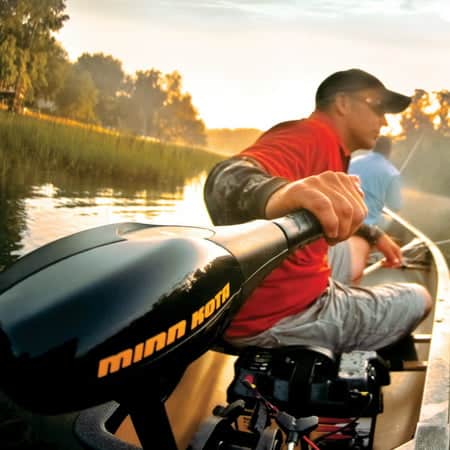
Maybe the most common type of trolling motor, transom mounts offer less control as we said above, but they save a lot of space and cost less. These are ideal on much smaller boats like a simple jon boat, because you just need to mount it to the transom and the bulk of the motor is now out of the way. They are also pretty easy to install and can be done by most people in a short amount of time.
Engine Mounted
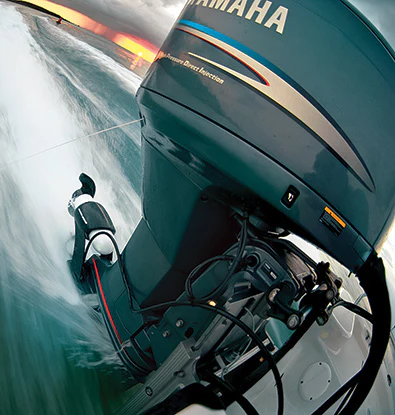
This type of trolling motor is not all that common but you’ll probably see one or two out there if you fish around other boats a lot. These motors are mounted right on the cavitation plate of your outboard motor, sort of like doubling down on engines.
The engine mounted trolling motor is controlled the same way you control your outboard normally, it’s just the thrust is being altered by using a different motor and prop. These are good if you don’t have any room for a trolling motor to mount anywhere else and maybe you don’t plan to always be using your boat for fishing.
The big drawback for an engine mounted trolling motor is that it offers the least control of the three types. It’s also more expensive than either of the others, which is why they tend to be less popular.
Vessel Size
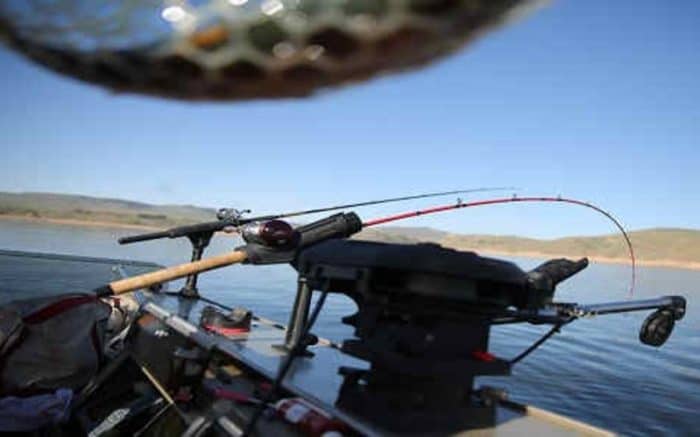
This is arguably the biggest factor in determining the size of your trolling motor after the type of boat you have. The general rule of thumb is that the bigger the boat the more thrust you need. Many boaters have a sort of standard formula but for my purposes, I find the 5 lbs of thrust for every 200 lbs of boat weight to be a good rule of thumb.
That may seem a little steep and I know some people would recommend a tweaked version of that, but this is looking at a few factors. The weight of your boat is the chief factor here but when you also account for things like the way a larger vessel reacts in strong wind or currents, how it manages chop, and how a longer, heavier boat maneuvers. This is especially true if we’re talking about a transom mount. Because there are factors beyond just the weight of the boat working against the motor, I think it’s good to have a little more oomph behind the motor when possible.
A trolling motor is doing its job if it can get you on plane and allow the boat to cruise along at 3 or 4 miles per hour. It also needs to be strong enough to keep you on a fairly straight line, even if there’s a mild current or some wind working against you. If you find currents, wakes and wind are pushing you too far off course, you probably need a more powerful trolling motor.
Based on my personal preference here, the calculation for thrust you want to use is:
Boat weight/100 X 2.5
Let’s do an example with a 2500 lb boat so you can see where we’re coming from.
2500/100 x 2.5 =
25 x 2.5 =
62.5 lbs of thrust
A boat that weighs 2500 lb is probably about 17 feet in length. You should be able to look up your specific boat weight in the owner’s manual but if you aren’t able to find it, you can check this online guide that offers the specs of most, but not all, popular models.
Keep in mind, the weight of your boat alone is just one part. You need to factor in the weight of the gear and passengers as well, which can add a few hundred pounds easily. Fully loaded boat weight is the number you need here.
Size and Thrust Examples
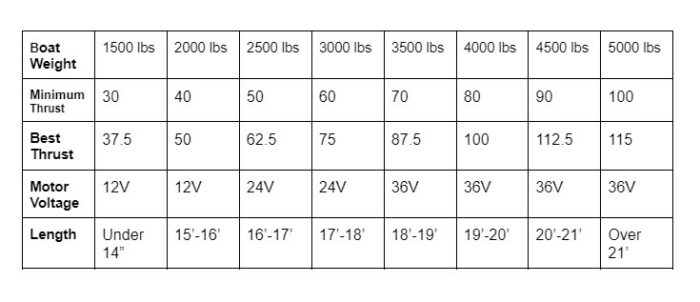
Choosing the Voltage of Your Trolling Motor
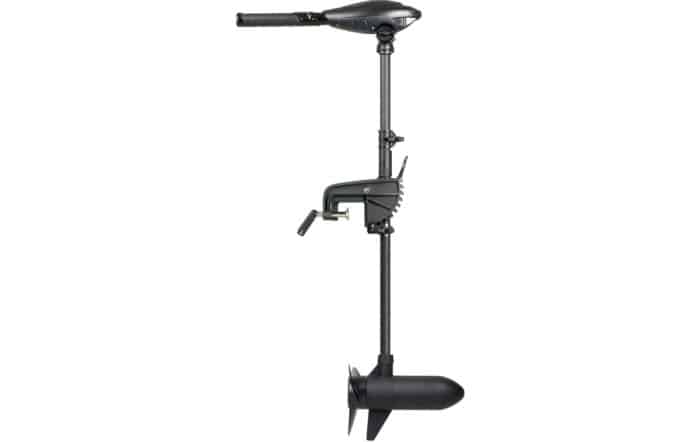
Trolling motors come in three voltages typically. Higher voltage relates to higher power. Most trolling motors will be 12V, 24V or 36V.
12V of power needs one dedicated battery to operate it and can be relied on for up to 55 lbs of thrust for your boat. If that’s not enough for your vessel you can move up to 24V.
24V trolling motors need two batteries. This can offer up to 80 lbs of thrust for your vessel.
36V will require three dedicated batteries to operate. You can get up to about 115 lbs of thrust with a 36V trolling motor.
As you increase the size of your motor, you’re obviously increasing the overall boat weight and the power you’ll need to move it all around as well. Each of those batteries you use is probably adding 20 lbs and up to 60 lbs to your total weight depending on what batteries you choose.
One more thing to remember about these differences is the time on the water. You may find that 55 lbs of thrust is perfect for your boat and so you only need a 12V motor. However, if you use a 24V motor you will double the size of your motor but you will also greatly increase the time you can stay out before the batteries die on you. So you may not technically need the larger motor, but you can still benefit from it.
If you like long fishing trips and want to make a day of it, you’ll find a 24V motor much better than a 12V. And if you’re really serious then obviously a 36V could ensure a full day of fishing. Just make sure you check the power draw for recharging your batteries to make sure you can handle it.
Trolling Motor Shaft Length

The shaft length is another important factor in ensuring you get the right trolling motor for your boat. We mentioned above in relation to pontoons that you’d need a longer shaft for those as the engine, by nature, will be sitting higher out of the water. The ideal shaft length is not as simple as just one that reaches the water or the longest one you can get either. You need to find the sweet spot to ensure the bust thrust with the least drag.
If the shaft length of your trolling motor is too long you’re going to increase drag and decrease performance. And while that’s annoying, it does get worse. The longer your shaft length, if it’s excessive, the greater the risk of damaging your motor. You don’t want the prop getting tangled in weeds or running into rocks and other junk that’s on the bottom of the lake.
Additionally, if you end up with a trolling motor shaft that’s too long it can be a real pain to transport it and store it properly as well.
If your shaft is too short you can have issues with cavitation and poor thrust as well, so you want to avoid both. That said, if you’re ever in doubt when choosing a motor shaft length, always pick longer. There are lots of ways you can adjust the shaft length to take it up if it’s too long. There is almost nothing you can do to make it longer if it’s too short.

The shaft length is something you’ll need to custom fit to your boat based on a few factors. Most significant for choosing your length are:
- Distance between mounting point and waterline
- If you’re boating in saltwater or freshwater
Getting the measurement can be a bit of a challenge so make sure you’re doing it in calm water and you’re being safe. More than one boater, leaning over the bow to try to measure from the mounting bracket to the water, has fallen in.
Keep in mind that the weight of your boat is going to change from time to time based on who and what is on board. More weight is going to put your boat closer to that water line so adjust your measurements as necessary. Do your best to measure with your boat outfitted for going out – so all the gear, fuel and people you’d normally have in board. Also, if you’re bow mounting, don’t forget about the bow dip you may experience, especially in lighter boats.
So, there’s another general rule of thumb for picking shaft lengths here. For a transom mounted motor you need to take the length between the transom and the waterline that you have measured and add 20 inches. This is for freshwater boating. If you’re boating in saltwater, then bump that up to 25 inches.
Depending on where and how you fish, you can play with these numbers a little bit. For instance, if you tend to fish in inlets or places where there is going to be chop regularly, it may be a good idea to add an extra inch or two to your measurements to prevent cavitation as the motor bobs up and down in the rough water.
The propeller from your trolling motor should be at least 12 inches below the surface of the water. In rougher waters it’s better to be deeper still. The reason you need those extra 20 to 25 inches is, in part, because the motorhead can be as much as 8 inches or more above the mounting area and you’ll need the full length to ensure you have at least 12 inches below the waterline.
The higher up in the water your motor is operating, the more cavitation you’ll get and that basically ruins the point of using a trolling motor at all. You’ll be churning the water like a cappuccino machine and scaring the fish away which is not ideal, so it’s best to keep it down at the proper depth whenever possible.
If your shaft length is too long there should be a depth collar adjustment you can use to tweak it and pull it up in the water some. This is why a longer shaft is easier to deal with than a shorter one. There’s no way to drop a shorter shaft length deeper into the water.
The Bottom Line
There are a handful of factors that can help you determined what size electric trolling motor you need but in general you want a trolling motor that offers 5 lbs of thrust for every 200 lbs of boat as well as a shaft length that is at least 20 inches longer than the distance between the waterline and where the motor is being mounted. You’ll also need to consider the voltage size of your electric motors with an eye to not just how much thrust is ideal for your sized vessel but how much time you want to spend out on the water before the batteries will need a charge.
Categories: Boats











